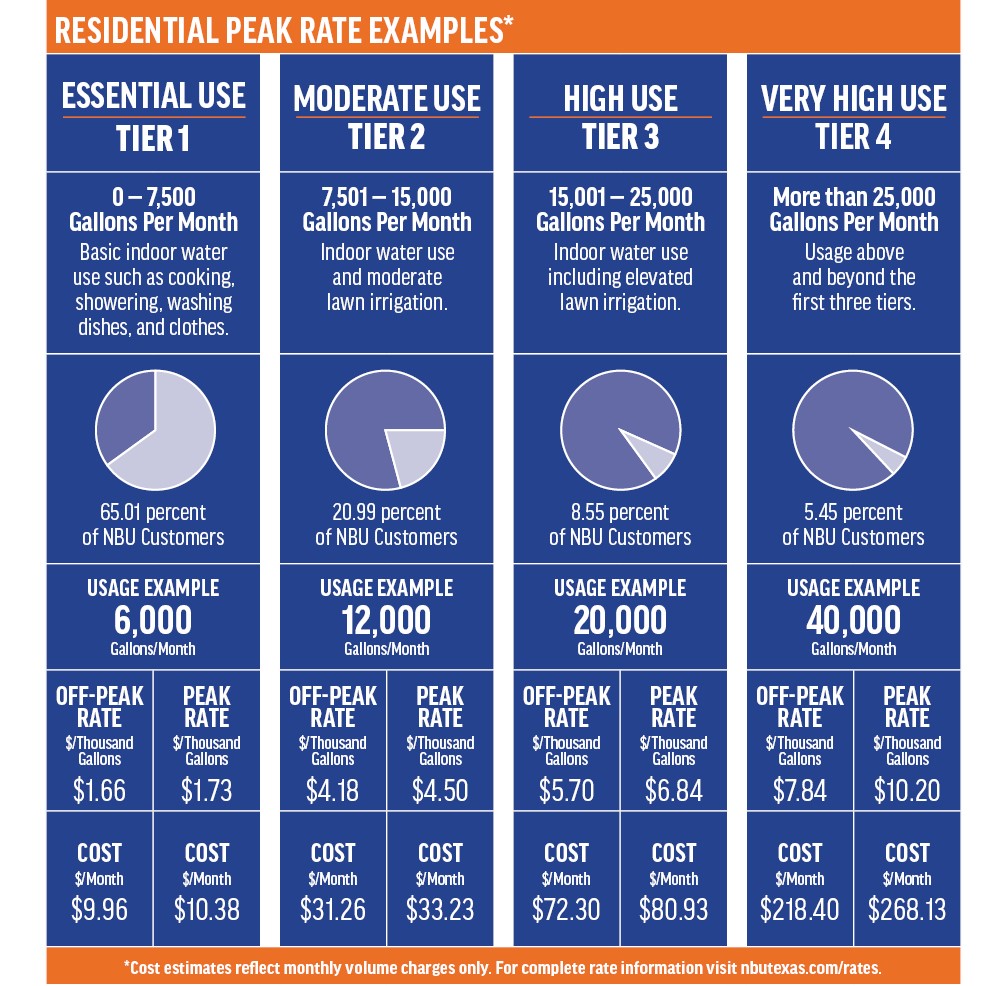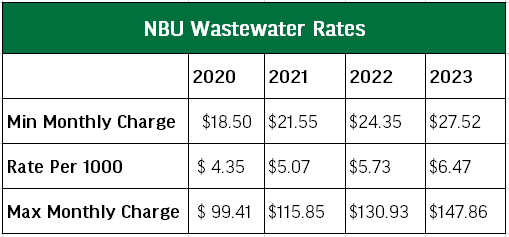Water Rate and Structure Explanation
In fall 2020, the New Braunfels City Council approved a New Braunfels Utilities (NBU) rate plan that increases water and wastewater rates through 2023. These rate increases are driven primarily by the need to acquire water supply, build and maintain infrastructure, keep up with growth, and meet regulatory requirements.
Communities across Texas are working to ensure they have acquired access to enough water to meet their growing communities’ needs, NBU is no different. New Braunfels Utilities has a history of maintaining a diversified water portfolio that focuses on having an adequate water supply to meet community growth. New Braunfels Utilities has water rights to cover NBU’s projected water supply needs well into the future. As with any market, as demand increases, so does the cost of supply. In Texas, there is a growing cost associated with maintaining adequate supply to meet the population’s needs.
In addition to acquiring the water rights to service NBU’s growing community, NBU must also build the infrastructure to service new areas while also working to maintain and upgrade existing infrastructure. These needs are driven not only by growth but also by local and state regulations related to water and wastewater infrastructure. The costs associated with water and wastewater infrastructure are more significant than installing and upgrading electrical infrastructure due to the intensive construction processes involved.
Rate Design
In creating the new water and wastewater rates, NBU worked with Boston University’s Institute for Sustainable Energy to develop rates that protect essential-use water for all customers, ensure revenue recovery for system resiliency, and send price signals to encourage water conservation.
The NBU residential customer’s essential-use average monthly water usage is approximately 6,000 gallons per month, this typically consists of drinking, bathing, and internal home use. Moderate usage, which includes essential use and some landscape watering/outdoor use, equates to total monthly usage of between 7,500 and 15,000 gallons per month. Water use above 15,000 gallons per month is typically deemed high use and includes nonessential usage. This table shows the total number of customers at each water usage level. Viewing the table at the 15,000 – 25,000 gallons usage range shows that more than 3,550 NBU customers use water within this range, and approximately 95 percent of NBU customers use less than 25,000 gallons of water per month.

New Braunfels Utilities has a long-term water goal of reducing the average daily usage per person, also known as gallons per capita per day (GPCD), from its current 168 GPCD to 120 GPCD. Water conservation is among NBU’s highest priority. In many ways, water conservation is the same as adding additional water supply, and it is the most economical form of water.
The newly approved rates will affect all customers over the next three years, with the most considerable impact on those customers whose water use is in the high or very high use ranges. A conservation mechanism built into NBU’s rates includes “Off-peak and On-Peak” pricing rates. Off-Peak months are October through May, with the summer months of June through September being On-Peak months. During On-Peak months, the higher cost of water is designed to reflect the impact water demand has during those critical summer months.
Along with On-Peak pricing, there is a water supply fee (WSF) charged on monthly water usage per every 1,000 gallons used above 7,500 gallons. This supply fee is to cover the cost of new water supply.
The tables below outlines how the forecasted three-year rate increases will impact a customer’s water bill. Knowing how much water you use every month determines the cost range you paid for water in 2020. Then follow the table to the right to find the forecasted cost range you may pay if your water usage stays the same. It is important to note that the rate increase will have a 114 percent effect to all customers’ essential water use of 7,500 gallons or less over the three-year time period. This percent increase is equivalent to a total of $4.00 in 2023.
Forecasted Customer Water Cost Ranges FY2020-2023 Based on Usage
Domestic On-Peak (June 1 – September 30)
| Tier | Usage | FY2020 Min-Max | FY2021 Min-Max | FY2022 Min-Max | FY2023 Min-Max |
| I – Essential Use | 0 – 7,500 | $0 – $27 | $0 – $26 | $0 – $28 | $0 – $31 |
| II – Moderate Use | 7,501 – 15,000 | $27 – $61 | $26 – $67 | $28 – $83 | $31 – $91 |
| III – High Use | 15,001 – 25,000 | $61 – $128 | $67 – $146 | $83 – $182 | $91 – $199 |
| IV – Very High Use | 25,001 – 50,000 | $128 – $375 | $146 – $427 | $182 – $520 | $199 – $566 |
| IV – Very High Use | 50,000 – 75,000 | $375 – $621 | $427 – $709 | $520 – $858 | $566 – $933 |
| IV – Very High Use | 75,001 – 100,000 | $621 – $868 | $709 – $990 | $858 – $1,196 | $993 – $1,300 |
Domestic Off-Peak (October 1 – May 31)
| Tier | Usage | FY2020 Min-Max | FY2021 Min-Max | FY2022 Min-Max | FY2023 Min-Max |
| I – Essential Use | 0 – 7,500 | $0 – $26 | $0 – $26 | $0 – $28 | $0 – $30 |
| II – Moderate Use | 7,501 – 15,000 | $26 – $58 | $26 – $65 | $28 – $80 | $30 – $87 |
| III – High Use | 15,001 – 25,000 | $58 – $115 | $65 – $132 | $80 – $167 | $87 – $182 |
| IV – Very High Use | 25,001 – 50,000 | $115 – $306 | $132 – $355 | $167 – $441 | $182 – $480 |
| IV – Very High Use | 50,000 – 75,000 | $306 – $498 | $355 – $577 | $441 – $715 | $480 – $779 |
| IV – Very High Use | 75,001 – 100,000 | $498 – $689 | $577 – $799 | $715 – $989 | $779 – $1,077 |
Irrigation On-Peak (June 1 – September 30)
| Tier | Usage | FY2020 Min-Max | FY2021 Min-Max | FY2022 Min-Max | FY2023 Min-Max |
| I – Essential Use | 0 – 7,500 | $0 – $51 | $0 – $60 | $0 – $75 | $0 – $81 |
| II – Moderate Use | 7,501 – 15,000 | $51 – $101 | $60 – $119 | $75 – $149 | $81 – $162 |
| III – High Use | 15,001 – 25,000 | $101 – $169 | $119 – $198 | $149 – $248 | $162 – $270 |
| IV – Very High Use | 25,001 – 50,000 | $169 – $397 | $198 – $460 | $248 – $565 | $270 – $615 |
| IV – Very High Use | 50,000 – 75,000 | $397 – $626 | $460 – $722 | $565 – $882 | $615 – $960 |
| IV – Very High Use | 75,001 – 100,000 | $626 – $855 | $722 – $985 | $882 – $1,199 | $960 – $1,306 |
Irrigation Off-Peak (October 1 – May 31)
| Tier | Usage | FY2020 Min-Max | FY2021 Min-Max | FY2022 Min-Max | FY2023 Min-Max |
| I – Essential Use | 0 – 7,500 | $0 – $43 | $0 – $51 | $0 – $65 | $0 – $71 |
| II – Moderate Use | 7,501 – 15,000 | $43 – $84 | $51 – $100 | $65 – $128 | $71 – $140 |
| III – High Use | 15,001 – 25,000 | $84 – $138 | $100 – $165 | $128 – $213 | $140 – $232 |
| IV – Very High Use | 25,001 – 50,000 | $138 – $323 | $165 – $380 | $213 – $479 | $232 – $522 |
| IV – Very High Use | 50,000 – 75,000 | $323 – $508 | $380 – $595 | $479 – $745 | $522 – $812 |
| IV – Very High Use | 75,001 – 100,000 | $508 – $692 | $595 – $810 | $745 – $1,011 | $812 – $1,101 |

Wastewater Rates
The wastewater rates also increase over the three years as well. Wastewater rates are calculated using a customer’s three lowest months of water usage in a rolling 12-month period. The average for all NBU customers is currently 4,600 gallons.
Rate Comparison
The rate increases were designed and implemented to help cover the costs of additional water supply, infrastructure, treatment, and regulatory compliance. When comparing NBU’s rates with those of surrounding communities, NBU’s rates are still some of the lowest in the area.
Tools for Managing Utility Costs
Take proactive steps to keep your utility bill as low as possible. Taking control of your water use and implementing conservation techniques when using water outdoors will have the most significant effect. New Braunfels Utilities has many tools available to help customers manage utility bills.
| Resources | Summary |
| After-Hours One on One Consultations | After-hours consultations on Tuesdays and Thursdays from 5:00 – 8:00 p.m. and Saturdays from 8:00 a.m. to 12:00 p.m. |
| Automated Threshold Alerts | Instruction on how to set automated threshold notifications if you are approaching a particular water or electric volume during the month. |
| Bill Assistance Program | Are you experiencing financial hardship, or would like to help customers in our community by donating to the NBU Utility Bill Payment Assistance program? |
| Bill Calculator | The Residential Utility Bill Calculator can help you estimate your monthly residential electric, water, and wastewater usage costs. |
| Budget Billing | Avoid big changes in your utility bill – especially during peak months when air conditioning, heating, and using the sprinkler system can increase bills. |
| Conservation Tips | To keep your utility bill as low as possible, take advantage of tips and information and help save water, energy, and money. |
| Conservation Videos | For conservation tips that can help manage utility costs, view these videos. |
| Consumption Usage Reports | Request a consumption report that shows how your usage compares to your neighborhood and community averages. |
| DIY Videos | Take the guesswork out of programing your irrigation meters and timers and learn how to set up your online account and manage usage alerts with our do-it-yourself videos. |
| Home Assessments | FREE water, energy, and irrigation assessments are a great way to identify waste and solutions that can help reduce utility expenses. |
| Leak Detection Checklist | Annual household leaks waste over 10 trillion gallons of water per year nationwide. New Braunfels Utilities offers helpful advice to ensure your pipes are sealed and do not contribute to this statistic. |
| Rebates | Get more for less with energy and water rebates. For more information, call the NBU Customer Solutions Department. |
| Track and View Interval Usage | Interval data is dependent on the meter type and data that’s collected. |
| Understanding Your Bill | New Braunfels Utilities wants to help break down the details of your bill for easy processing. Easily find the important information – the amount due to the due date and usage totals – and further understand your consumption data. |
| Virtual Assessments | FREE Virtual Performance Assessments are conducted on-line or over the phone without NBU personnel visiting your home. |